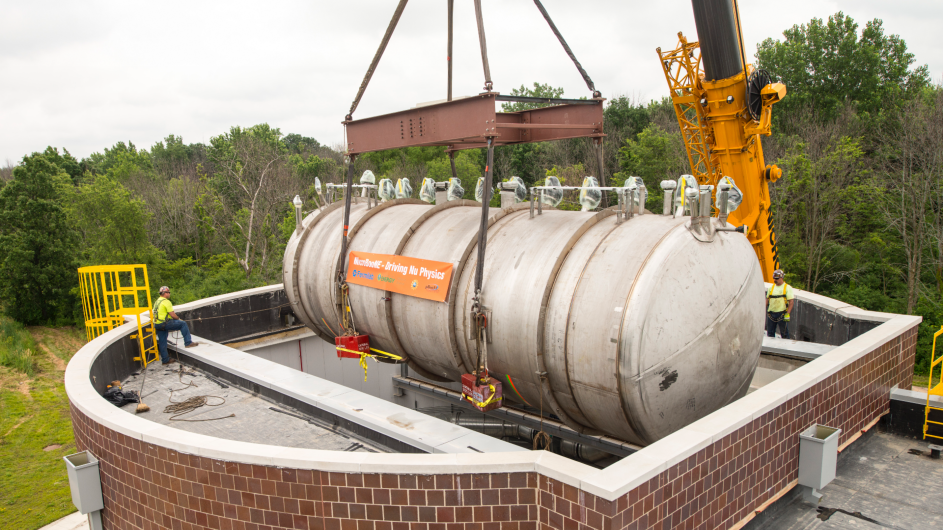A Longtime Search at Fermilab for a Fourth Kind of Neutrino Ends with New Questions
The long-running MicroBooNE experiment at Fermilab has found no signs of a proposed new particle, the sterile neutrino, but the experiment offers insight into unexplained electron-like events found in an earlier experiment.

The long-running MicroBooNE experiment at the U.S. Department of Energy’s Fermi National Accelerator Laboratory has found no signs of a proposed new particle, the sterile neutrino, but the experiment offers insight into unexplained electron-like events found in the previous MiniBooNE experiment.
“These new MicroBooNE results do not fit in with our expectations from the previous MiniBooNE experiment,” said Michael Shaevitz, a physics professor at Columbia University and MicroBooNE collaborator. “Now we have to figure out what they’re telling us about neutrinos and the physics of what we observed at MiniBooNE.”
MicroBooNE explores a striking anomaly in particle beam experimentation first uncovered by researchers at Los Alamos National Laboratory. In the 1990s, the lab’s Liquid Scintillator Neutrino Detector experiment saw more electron-like events than expected under the standard model of physics, the theory that explains the fundamental forces of nature.
The MiniBooNE experiment was launched at Fermilab in 2002 to investigate the Los Alamos result in more detail. It, too, found more electron-like events than the standard model predicted, but the MiniBooNE detector had one drawback: it couldn’t differentiate between electrons or photons exiting from where the neutrino interacted.
The MicroBooNE experiment sought to investigate the source of this anomaly with a detector built on state-of-the-art techniques and technology, which included more than 8,000 wires painstakingly attached to light sensors to capture particle tracks. The detector is housed in a 40-foot-long barrel filled with 170 tons of pure liquid argon. Neutrinos bump into the dense, transparent liquid, releasing additional particles that the electronics can record. The resulting pictures show detailed particle paths, and clearly distinguish electrons from photons.
Neutrino fans, rejoice! New #neutrino results are coming from the @MicroBooNE collaboration tomorrow. https://t.co/PLp5DzIP1k
— Fermilab (@Fermilab) October 26, 2021
Did you know that the #MicroBooNE experiment started up in 2015 and has run 24/7 since, making it the longest-running liquid-argon detector in history? pic.twitter.com/koHLd5kATJ
Watch Georgia Karagiorgi on PBS Nova
“These first results targeted some of the more likely explanations for the anomaly,” said Mark Ross-Lonergan, a Columbia postdoc and MicroBooNE collaborator who recently reported the first photon results. “Theorists have proposed some fascinating and exotic explanations. We look forward to working with them to get to the bottom of this mystery.”
MicroBooNE is one of several neutrino experiments searching for answers using liquid argon technology. The ICARUS detector is set to begin gathering physics data soon, and the Short-Baseline Near Detector (SBND) comes online in 2023. Together with MicroBooNE, the experiments form the Short-Baseline Neutrino Program at Fermilab, and will produce a wealth of neutrino data. SBND, for example, will be able to record the same amount of data in one month that MicroBooNE collected in two years. The MicroBooNE results released today will help guide the continuing research.
Further building on MicroBooNE’s techniques and technology, liquid argon will also be used in the Deep Underground Neutrino Experiment (DUNE), an experiment at Fermilab with more than 1,000 researchers from more than 30 countries. DUNE will study oscillations by sending neutrinos 800 miles underground to detectors at the mile-deep Sanford Underground Research Facility in South Dakota.
“We have only begun to scratch the surface of what’s causing the MiniBooNE anomaly,” said Georgia Karagiorgi, an associate physics professor at Columbia and a leader of the MicroBooNE photon analysis. “These first results point us toward where to look next.”
The Columbia Neutrino Group is funded by the U.S. National Science Foundation. The MicroBooNE collaboration includes 178 scientists and engineers from 36 institutions in the United States, Switzerland, United Kingdom, Spain, and Israel.